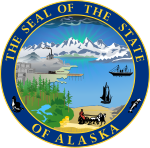Alaska Marriage Amendment | ||||||||||||||||||||||
| Results | ||||||||||||||||||||||
|---|---|---|---|---|---|---|---|---|---|---|---|---|---|---|---|---|---|---|---|---|---|---|
| ||||||||||||||||||||||

| ||||||||||||||||||||||
| Source:[1] | ||||||||||||||||||||||
Ballot Measure 2 of 1998 is a ballot measure, since ruled unconstitutional, that added an amendment to the Alaska Constitution that prohibited the recognition of same-sex marriage in Alaska. The Ballot measure was sparked by the lawsuit filed by Jay Brause and Gene Dugan, after the two men were denied a marriage license by the Alaska Bureau of Vital Statistics.[2] In Brause v. Bureau of Vital Statistics, 1998 WL 88743, the Alaska Superior Court ruled that the state needed compelling reason to deny marriage licenses to same-sex couples and ordered a trial on the question.[2] In response, the Alaska Legislature immediately proposed and passed Resolution 42, which became what is now known as Ballot Measure 2.[2] Ballot Measure 2 passed via public referendum on November 3, 1998, with 68% of voters supporting and 32% opposing.[3] The Bause case was dismissed following the passage of the ballot measure.
| Elections in Alaska |
|---|
 |
The text of the adopted amendment, which is found at Article I, section 25 of the Alaska Constitution, states:[4]
To be valid or recognized in this State, a marriage may exist only between one man and one woman.
On October 12, 2014, U.S. federal Judge Timothy Burgess struck down the ban as a violation of the U.S. constitutional guarantee of due process and equal protection.[5] Burgess wrote, "Alaska’s denial of the benefits and dignity of marriage for them only perpetuates this discrimination without legitimate grounds.” Burgess also barred Alaska from refusing to acknowledge lawful same-sex marriages conducted in other states.[6]
Article I, § 25. of the Alaskan Constitution remains an unconstitutional constitutional amendment to this day. It can repealed by either a state constitutional convention or by a legislatively referred constitutional amendment that requires a two-thirds vote in both the Alaskan State Senate and the Alaskan House of Representatives and a majority vote in a referendum.
- ^ Election Summary Report State of Alaska 1998 General Election OFFICIAL RESULTS
- ^ a b c Cite error: The named reference
DukeLawwas invoked but never defined (see the help page). - ^ Robinson, B.A. (September 10, 2007). "Same-sex marriage in Alaska". Ontario Consultants on Religious Tolerance. Retrieved April 8, 2009.
- ^ Alaska State Constitution Archived 2009-07-09 at the Wayback Machine Hosted on the Alaska Legislature's website. Accessed 30 November 2006.
- ^ Thiessen, Mark (October 12, 2014). "Federal Judge Strikes Down Alaska's Marriage Ban". ABC News. Retrieved October 12, 2014.
- ^ Quinn, Steve (October 12, 2014). "Alaska ban on same-sex marriage ruled unconstitutional". Reuters. Retrieved October 13, 2014.